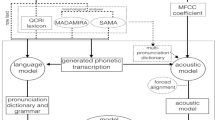Abstract
This paper pursues the goal of creating a reliable speech corpus based on The Holy Quran (THQ) audio recordings. Achieving that goal involves major steps to be done and essential requirements to be considered. With the availability of tremendous amount of recordings nowadays, it is of a fundamental importance to select the ones that feature both high audio quality and perfect reciter performance. Also, since the targeted beneficiaries from the corpus are the digital speech processing research community, it is also very essential to maintain an efficient, a familiar and a convenient way of presenting the audio corpus and other language material, such as the language model. Audio recordings of THQ are selected from four sources having a high standard regarding the reciters’ performance. A significant effort is made in phonetical transcription of the audio content such that the written transcript maps perfectly to the uttered phonemes. Furthermore, the corpus dictionary, which is usually required in many fields such as machine learning and datamining, is also created. The first release of the corpus consists of recorded recitations and the necessary metadata of three chapters of THQ of different lengths recited by four reference reciters. Those chapters are selected for this phase based on statistical analysis of the lengths of all chapters and the frequency of occurrence of the Arabic phonemes across all chapters of THQ.
Access this chapter
Tax calculation will be finalised at checkout
Purchases are for personal use only
Similar content being viewed by others
References
Alghamdi, M.: KACST Arabic phonetic database. In: The 15th International Congress of Phonetics Science; 3–9 August 2003; Barcelona, Spain, pp. 3109–3112. Universitat Autònoma de Barcelona, Barcelona (2003)
Alghamdi, M., Alhargan, F., Alkanhal, M., Alkhairy, A., Eldesouki, M., Alenazi, A.: Saudi accented Arabic voice bank. J. King Saud Univ. 20, 45–64 (2008)
BBN Technologies (with American University of Beirut a subcontractor), et al.: BBN/AUB DARPA Babylon Levantine Arabic Speech and Transcripts LDC2005S08, 1st edn. Linguistic Data Consortium, Philadelphia (2005)
LaRocca, S., Chouairi, R.: West Point Arabic Speech LDC2002S02, 1st edn. Linguistic Data Consortium, Philadelphia (2002)
King Fahd Glorious Quran Printing Complex. http://www.qurancomplex.org/
Alghamdi, M., Mohamed El Hadj, Y.O., Alkanhal, M.: A manual system to segment and transcribe Arabic speech. In: IEEE International Conference on Signal Processing and Communications (ICSPC), Dubai, United Arab Emirates, pp. 233–236 (2007)
AlQahtany, M.O., Alotaibi, Y.A., Selouani, S.-A.: Analyzing the seventh vowel of classical Arabic. In: 2009 International Conference on Natural Language Processing and Knowledge Engineering, NLP-KE 2009, pp. 1–7 (2009)
Definition of sun letter, Merriam-Webster Dictionary. https://www.merriam-webster.com/dictionary/sun%20letter. Accessed 24 May 2017
Acknowledgment
This project was funded by the National Plan for Science, Technology and Innovation (MAARIFAH), King Abdulaziz City for Science and Technology, Kingdom of Saudi Arabia, Award Number (11-INF1968-02).
Author information
Authors and Affiliations
Corresponding author
Editor information
Editors and Affiliations
Rights and permissions
Copyright information
© 2018 Springer International Publishing AG
About this paper
Cite this paper
Meftah, A., Seddiq, Y., Alotaibi, Y., Selouani, SA. (2018). Building a Rich Arabic Speech and Language Corpus Based on the Holy Quran. In: Lachkar, A., Bouzoubaa, K., Mazroui, A., Hamdani, A., Lekhouaja, A. (eds) Arabic Language Processing: From Theory to Practice. ICALP 2017. Communications in Computer and Information Science, vol 782. Springer, Cham. https://doi.org/10.1007/978-3-319-73500-9_7
Download citation
DOI: https://doi.org/10.1007/978-3-319-73500-9_7
Published:
Publisher Name: Springer, Cham
Print ISBN: 978-3-319-73499-6
Online ISBN: 978-3-319-73500-9
eBook Packages: Computer ScienceComputer Science (R0)




